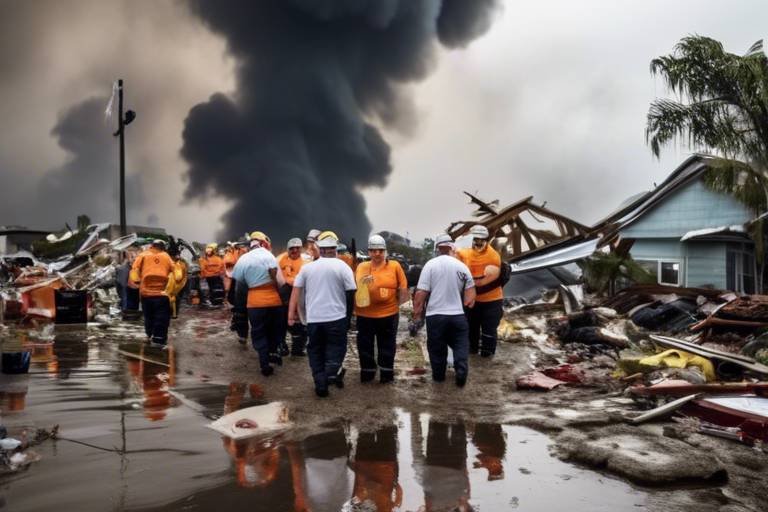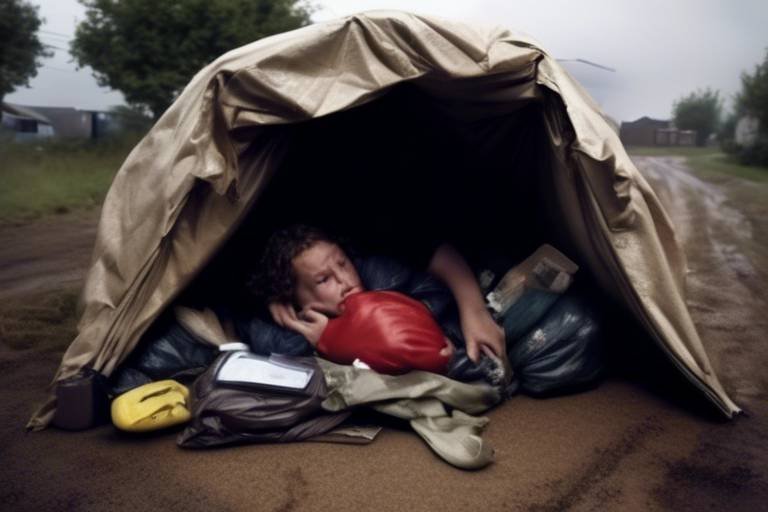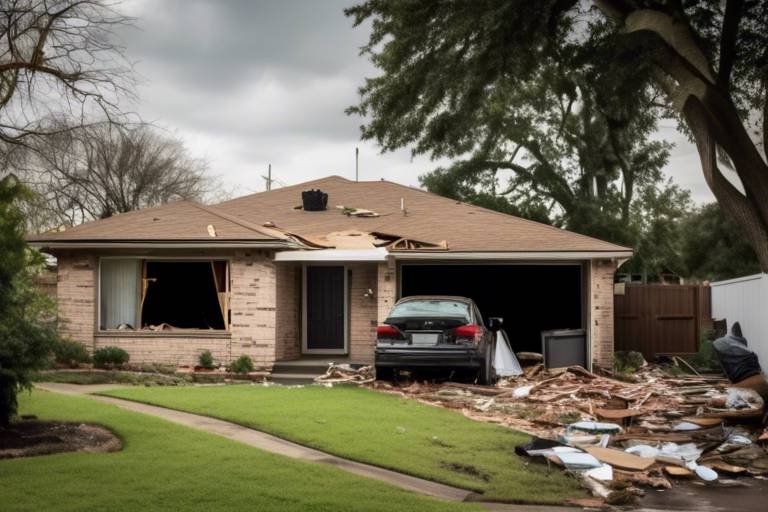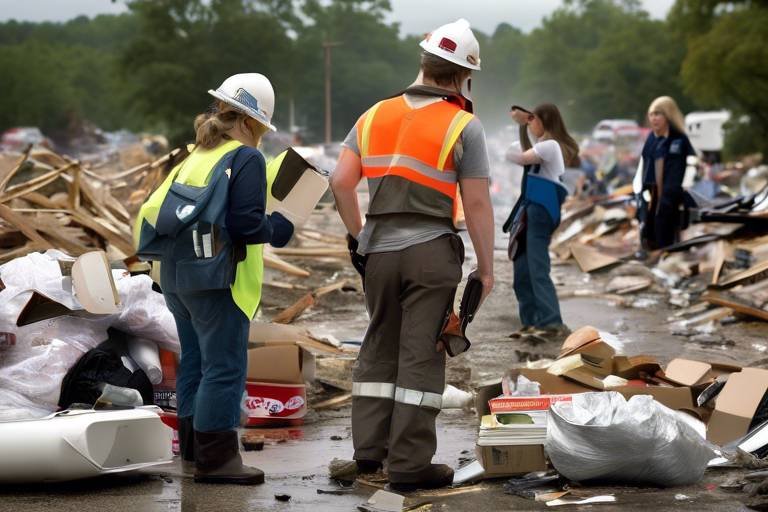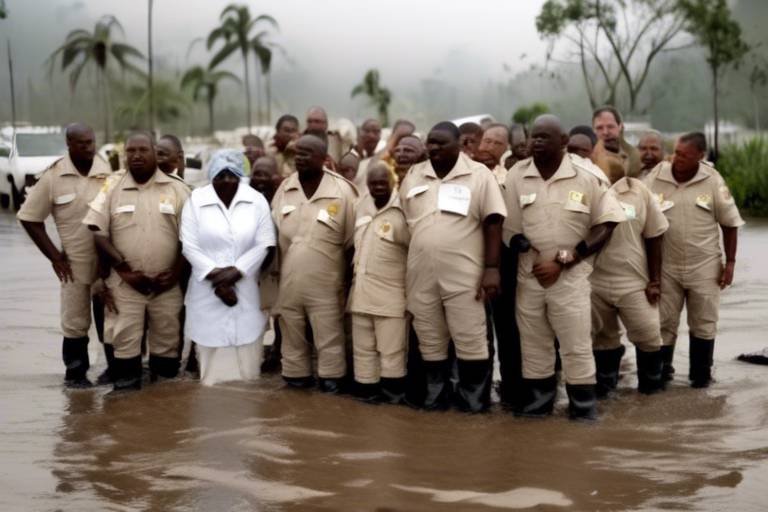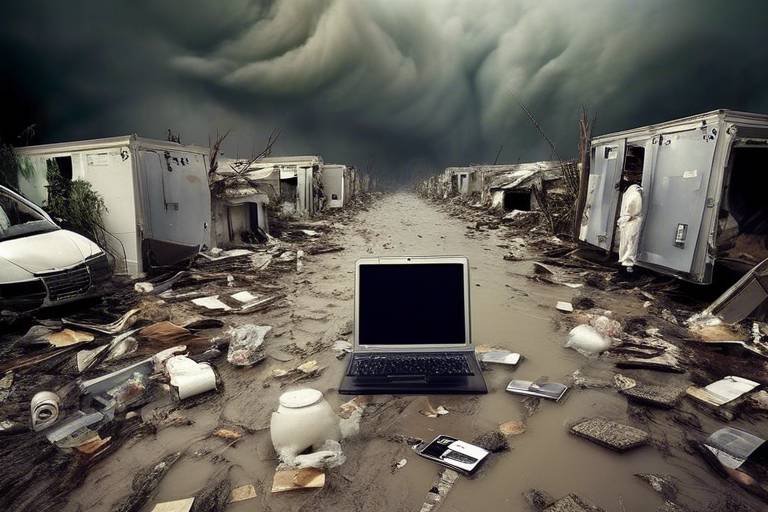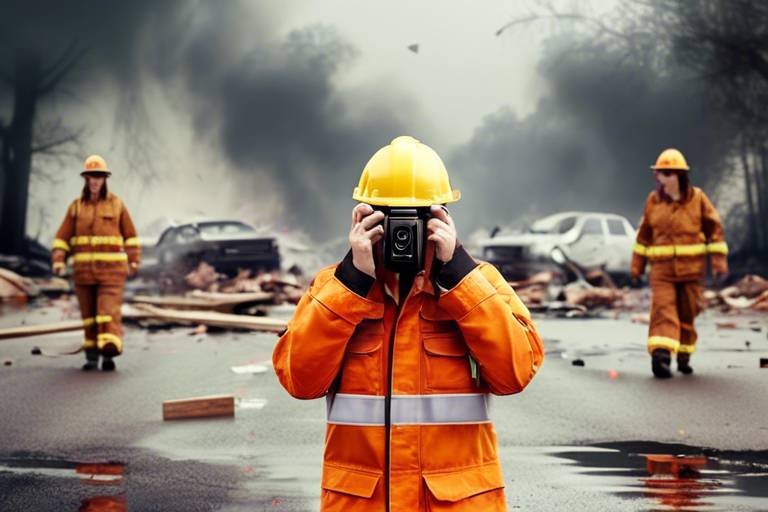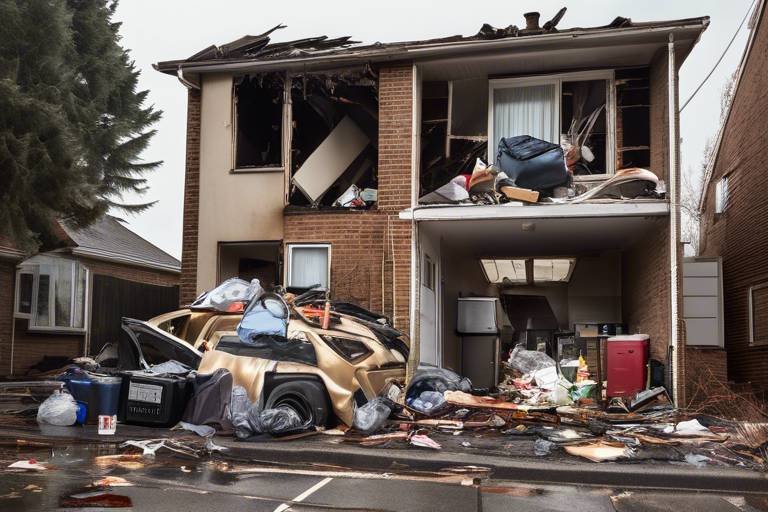Supporting Children During a Disaster - A Guide for Parents
When disaster strikes, it can feel like the ground beneath us has shifted, leaving us in a state of uncertainty and fear. As parents, our primary instinct is to protect our children, but how do we do that when chaos reigns? This article provides essential strategies for parents to support their children emotionally and psychologically during disasters, ensuring their safety and well-being while navigating challenging circumstances. Just like a ship needs a sturdy anchor in a storm, our children need our guidance and reassurance to weather the emotional upheaval that disasters can bring. By understanding their reactions, creating safety plans, and maintaining open lines of communication, we can help them navigate through these turbulent times. Let’s dive deeper into how we can effectively support our little ones when they need us the most.
Children respond to disasters in various ways. Some may become withdrawn, while others might display anger or anxiety. Recognizing these reactions is crucial for parents to provide appropriate support and reassurance. Just like a flower needs sunlight to bloom, children need understanding and patience to process their feelings and fears effectively. It’s essential to remember that their reactions can vary based on their age and personality. For instance, younger children might not fully grasp the situation, leading them to express their fears through play or regression, while older children may articulate their worries more clearly but still need help managing their emotions. By observing their behavior and providing a safe space for expression, parents can help their children navigate through these challenging emotions.
Developing a comprehensive safety plan is vital for families. Think of it as creating a roadmap for navigating through a stormy sea. This plan should include communication strategies and emergency contacts tailored to children's needs. Start by discussing potential disasters that could affect your area, such as floods, earthquakes, or wildfires. Involve your children in the planning process to empower them and alleviate their fears. Make a list of important contacts, including family members, neighbors, and emergency services, and ensure your children know how to reach them. Additionally, practice your plan regularly, so it becomes second nature. This proactive approach not only enhances safety but also instills a sense of control and confidence in your children.
Open and honest communication is essential during a disaster. Parents can learn techniques to discuss the situation with their children, fostering an environment of trust and understanding while addressing their concerns. Use simple language and age-appropriate explanations to help them grasp the situation without overwhelming them. For instance, instead of saying, “We might lose our house,” you could say, “We need to be prepared in case we have to leave for a little while.” Encourage your children to ask questions and express their feelings, validating their concerns. Remember, it’s okay not to have all the answers; your presence and willingness to listen can be incredibly comforting.
Emotional support helps children cope with stress and anxiety. This section explores various ways parents can comfort their children, validate their feelings, and encourage healthy emotional expression during difficult times. A warm hug or a reassuring word can go a long way in helping children feel safe. Encourage them to talk about their feelings, and reassure them that it’s normal to feel scared or upset. You can also use creative outlets like drawing or journaling to help them express their emotions. By allowing them to share their worries and feelings, you’re not only providing comfort but also teaching them valuable coping skills.
Maintaining a sense of routine can provide comfort to children during chaos. Just as a lighthouse guides ships safely to shore, a structured environment offers stability amidst uncertainty. Try to keep daily routines as consistent as possible, whether it’s mealtime, bedtime, or playtime. This predictability can help children feel more secure and grounded. Involve them in household activities to foster a sense of normalcy, and encourage family time to strengthen bonds. Remember, even small rituals, like reading a bedtime story, can provide a comforting anchor in their day.
Play is a powerful tool for processing emotions. Here, we discuss how parents can incorporate play and engaging activities to help children express their feelings and distract them from stressors. Activities like drawing, building with blocks, or even role-playing can be effective ways for children to express what they’re feeling inside. You can also create games that focus on teamwork and problem-solving, helping them channel their energy positively. Engaging in these activities not only provides a distraction but also fosters resilience and creativity, allowing children to explore their feelings in a safe space.
Sometimes, children may need additional support from professionals. This section highlights signs that indicate when it's time to seek help from counselors or therapists specialized in trauma and disaster response. If your child shows persistent signs of distress, such as nightmares, withdrawal, or changes in behavior, it may be time to reach out for help. Professional support can provide children with coping strategies and a safe space to process their feelings. Remember, seeking help is a sign of strength, not weakness, and it can make a significant difference in your child's emotional well-being.
Teaching resilience is crucial for children facing adversity. This part provides strategies for parents to foster resilience, empowering children to adapt and thrive in the face of future challenges. Resilience is like a muscle; the more we exercise it, the stronger it becomes. Encourage your children to face challenges head-on and celebrate their efforts, no matter the outcome. Share stories of overcoming obstacles, whether from your own life or from books and media, to inspire them. By instilling a growth mindset and emphasizing the importance of perseverance, you’re equipping your children with the tools they need to navigate life’s storms.
- How can I tell if my child is struggling emotionally after a disaster? Look for changes in behavior, such as increased clinginess, nightmares, or withdrawal from activities they once enjoyed.
- Should I talk to my child about the disaster? Yes, open communication is essential. Use age-appropriate language and encourage them to express their feelings.
- What if my child refuses to talk about their feelings? Respect their space but gently encourage expression through creative outlets like drawing or storytelling.
- When should I seek professional help for my child? If signs of distress persist for weeks or interfere with daily life, consider consulting a mental health professional.

Understanding Children's Reactions
When a disaster strikes, it can feel like a storm has rolled into a child's world, turning everything upside down. Children, much like adults, experience a whirlwind of emotions during such times, but their reactions can often be more intense and unpredictable. It's crucial for parents to recognize that children may respond in various ways, depending on their age, personality, and previous experiences. Understanding these reactions is the first step in providing the necessary emotional support and reassurance.
For younger children, the reactions might manifest through behaviors rather than words. They may become clingy, regress to earlier developmental stages, or express their feelings through play. Imagine a toddler who once confidently played alone now seeking constant reassurance from their parent. This is a natural response to the chaos around them. On the other hand, older children might express their feelings more verbally but may still struggle to articulate their fears and anxieties. They might exhibit mood swings, irritability, or even withdrawal from social interactions. It's essential for parents to be observant and patient, helping children navigate their emotions.
Here’s a quick breakdown of common reactions based on age groups:
| Age Group | Common Reactions |
|---|---|
| Infants (0-2 years) | Increased crying, changes in sleeping or eating patterns, clinginess. |
| Preschoolers (3-5 years) | Regression in behavior, nightmares, play that reflects fear. |
| School-age (6-12 years) | Worrying, physical complaints (like stomachaches), changes in school performance. |
| Teenagers (13-18 years) | Anger, withdrawal, risky behaviors, or expressing feelings through art or writing. |
Recognizing these reactions can help parents provide the right support. For instance, if a child is exhibiting signs of anxiety, parents can help by encouraging open discussions about their feelings. Asking questions like, "What are you worried about?" or "Can you tell me how that makes you feel?" can foster an environment of trust and understanding. Remember, children often look to parents for cues on how to react; if they see calmness and reassurance, they are more likely to feel secure.
Moreover, it's important to validate their feelings. Telling a child, "It's okay to feel scared," can go a long way in helping them process their emotions. Parents can also model coping strategies, such as deep breathing or talking about their own feelings, showing children that it's normal to experience a range of emotions during tough times. By understanding and acknowledging their reactions, parents can effectively support their children through the emotional turbulence that disasters can bring.

Creating a Safety Plan
When it comes to safeguarding your family during a disaster, preparation is key. Creating a safety plan isn't just a good idea; it's a necessity that can significantly reduce anxiety and chaos when disaster strikes. Imagine being in the middle of a storm, and instead of panicking, you and your children are calmly executing a plan. Sounds ideal, right? To achieve this, you need to involve your children in the planning process, making them feel empowered and informed rather than scared and confused.
Start by discussing potential disasters that could occur in your area. For instance, if you live in a region prone to hurricanes, it's important to talk about what that means for your family. Use simple language and be honest about the risks, but also emphasize the steps you will take to stay safe. This conversation should include:
- Types of disasters: Discuss various scenarios, such as earthquakes, floods, or fires, so children understand what to expect.
- Emergency contacts: Create a list of important phone numbers, including family members, neighbors, and local emergency services.
- Safe meeting places: Designate a safe place where your family can meet if you are separated during a disaster.
Next, develop a communication strategy. In the chaos of a disaster, staying connected can be challenging. Consider the following:
| Communication Method | Description |
|---|---|
| Text Messaging | Encourage family members to use text messages, as they often go through when calls cannot. |
| Social Media | Set up a family group chat or a private social media group to share updates quickly. |
| Emergency Apps | Download apps designed for emergencies that provide alerts and information. |
Incorporating these methods into your safety plan ensures that everyone knows how to reach each other and stay informed. Additionally, practice your safety plan regularly. Just like fire drills in school, rehearsing your plan at home will help your children understand what to do when the time comes. Make it a fun family activity! You could even set up a scavenger hunt to find emergency supplies or role-play different disaster scenarios.
Lastly, don’t forget to prepare an emergency kit. This kit should include essential items like food, water, first-aid supplies, and any medications your family may need. Involve your children in assembling the kit. This not only teaches them about preparedness but also gives them a sense of ownership and responsibility. Here’s a quick checklist of items to include:
- Non-perishable food (like granola bars or canned goods)
- Water (at least one gallon per person per day)
- First-aid supplies
- Flashlights and batteries
- Whistle (to signal for help)
- Personal hygiene items
Creating a safety plan may seem daunting, but breaking it down into manageable steps can make it more approachable. Remember, the goal is to ensure your family's safety and well-being while providing your children with a sense of security and control. With a well-thought-out plan in place, you can navigate through any disaster with confidence.

Communicating Effectively
When a disaster strikes, the world around us can feel like it's turned upside down. It's during these tumultuous times that effective communication becomes a lifeline for both parents and children. But how do we navigate these tricky conversations? First off, it’s essential to create a safe space for your child. This means being approachable and ready to listen without judgment. Children often have a myriad of questions swirling in their minds, and as a parent, it’s your job to help them untangle those thoughts.
Start by asking open-ended questions like, “What are you feeling right now?” or “Can you tell me what you’re thinking about?” This not only encourages them to express their emotions but also shows that you genuinely care about their feelings. Remember, it’s not just about giving answers; it’s about fostering an environment where they feel comfortable sharing their fears and concerns. Active listening is crucial here. Nod your head, maintain eye contact, and respond to their feelings with empathy. For instance, if they express fear, validate that feeling by saying, “It’s okay to feel scared. Many people feel the same way.”
While it's important to be honest, you also need to be mindful of the information you share. Tailor your explanations to their age and maturity level. For younger children, you might say, “There’s a storm coming, and we’re going to stay safe together,” while older kids might appreciate more details about the situation. However, avoid overwhelming them with too much information or graphic details that could heighten their anxiety.
In addition to verbal communication, consider using visual aids to help explain complex situations. A simple drawing or a storybook about disaster preparedness can make the concept more relatable and less intimidating. You can also use role-playing to practice what to do in various scenarios, which can empower children by giving them a sense of control.
Furthermore, it’s essential to check in regularly with your child. Communication shouldn't just happen during crises; it should be an ongoing conversation. Ask them how they’re feeling about the situation as it evolves and reassure them that it’s normal to have ups and downs. Encourage them to express their thoughts through art, journaling, or even talking to a trusted friend. This can help them process their emotions and reinforce that they are not alone in their feelings.
Finally, remember that your own emotional state can influence your child. If you’re feeling anxious or stressed, they may pick up on that energy. Practice self-care and talk to someone you trust about your feelings, so you can approach conversations with your child from a place of calm and reassurance. After all, the goal is to build a bridge of trust and understanding that will help them feel secure even in the midst of chaos.
- How can I tell if my child is struggling to cope with a disaster?
Look for signs like changes in behavior, increased clinginess, or withdrawal from activities they used to enjoy. If you notice persistent changes, it may be time to seek professional help. - What should I do if my child refuses to talk about the disaster?
Respect their space, but gently encourage them to share when they’re ready. Sometimes, engaging in a relaxing activity together can open the door to conversation. - Is it okay to share my own feelings with my child?
Yes, but be mindful of how you present your emotions. Share your feelings in a way that reassures them you are handling the situation and that it's okay to feel a range of emotions.

Providing Emotional Support
When disaster strikes, children often find themselves engulfed in a whirlwind of emotions. As parents, it’s our duty to provide them with the emotional support they need to navigate through these turbulent times. It's like being a lighthouse in a storm—guiding them safely to shore amidst the chaos. Understanding that every child reacts differently is key; some may become withdrawn, while others might exhibit heightened anxiety or even anger. Recognizing these varied responses enables us to tailor our support effectively.
One of the most important things we can do is to validate their feelings. Children need to know that it's okay to feel scared, confused, or sad. You might say, "It's completely normal to feel upset right now. I feel that way too sometimes." This acknowledgment can be incredibly comforting, allowing them to express their emotions without fear of judgment. Remember, it's not just about what we say, but how we say it. Our tone and body language can convey a sense of safety and reassurance.
Engaging in open conversations is another effective way to provide emotional support. Encourage your child to share their thoughts and feelings about the disaster. Ask them questions like, "What are you most worried about?" or "How do you feel about what happened?" This approach not only fosters trust but also gives them an opportunity to articulate their fears and anxieties. Sometimes, children may struggle to find the right words. In those cases, using creative outlets such as drawing or storytelling can help them express what they might not be able to verbalize.
Moreover, it's essential to maintain a calm and composed demeanor. Children often take cues from their parents; if you appear anxious or overwhelmed, they may mirror those emotions. Instead, try to embody a sense of calmness. You could create a safe space at home where they can retreat to when feeling anxious—perhaps a cozy corner filled with their favorite books and toys. This physical space can serve as a metaphorical 'safe haven' where they can process their feelings in a comforting environment.
Another effective strategy is to incorporate routine and structure into their daily lives. When everything seems uncertain, having a predictable schedule can provide a sense of normalcy. You might say, "Even though things are tough right now, we can still have our family movie night on Friday!" This not only gives them something to look forward to but also reassures them that life will eventually return to a sense of normalcy.
Lastly, don't hesitate to seek help if your child is struggling to cope. It’s perfectly okay to reach out to professionals who specialize in childhood trauma. Signs that your child may need extra support include persistent nightmares, excessive clinginess, or a sudden drop in school performance. Remember, seeking help is a sign of strength—not weakness. It shows that you’re committed to ensuring your child’s emotional well-being.
In conclusion, providing emotional support during a disaster is about being present, listening, and validating your child's feelings. By fostering open communication, maintaining calmness, and creating a structured environment, you can help your child navigate through their emotions and emerge stronger on the other side.
- What should I do if my child refuses to talk about their feelings?
Encourage them gently, but don't force them. Sometimes, engaging in an activity they enjoy can help them open up naturally. - How can I tell if my child needs professional help?
Look for signs like withdrawal from friends, changes in eating or sleeping patterns, or persistent sadness. If you notice these, it might be time to consult a professional. - Is it okay for me to express my own feelings in front of my child?
Yes, but be mindful of how you express them. It's important to model healthy emotional expression while reassuring them that you are there to support them.

Encouraging Routine and Stability
When a disaster strikes, everything around us can feel like it’s spinning out of control. For children, this chaos can be particularly overwhelming. They thrive on routine and stability, which provide them with a sense of security. As parents, it’s essential to create an environment that helps anchor them during these turbulent times. Think of routine as a comforting blanket that wraps around your child, shielding them from the harsh winds of uncertainty.
Establishing a daily routine can significantly ease children's anxiety. Start by maintaining regular meal times and bedtimes, as these familiar markers can help ground them amidst the chaos. You might say, "Hey, let’s keep our breakfast at 8 AM, just like we always do!" This consistency is not just about keeping time; it’s about preserving a sense of normalcy. When everything else feels unpredictable, having a structured day can be a beacon of hope for your little ones.
Moreover, consider incorporating activities that your child enjoys into this routine. Whether it’s reading a favorite book, drawing, or playing games, these activities can serve as both distractions and coping mechanisms. Engaging in these enjoyable tasks allows children to express their feelings in a safe space, helping them process their emotions. You might even set aside a specific time each day for these activities, which can become a comforting ritual. For example, you could say, “After lunch, let’s have our art time together!”
In addition to daily routines, it's crucial to create a stable environment. This means ensuring that your home feels as safe and welcoming as possible. You can do this by involving your children in small, manageable tasks around the house. For instance, allowing them to help with setting the table or organizing their toys can instill a sense of responsibility and control. When children feel they have a part to play, it can help diminish feelings of helplessness.
Another effective strategy is to establish a family check-in time. This is a dedicated moment each day where everyone can share their thoughts and feelings. It could be during dinner or right before bedtime. This practice not only strengthens family bonds but also provides children with an opportunity to voice their concerns. You might say, “Let’s all sit together and talk about our day. What made you happy? What made you worried?” This open dialogue can significantly alleviate children’s fears, making them feel heard and understood.
Lastly, remember that flexibility is key. While routines are important, it’s equally essential to adapt them as needed. If your child seems particularly anxious one day, it might be beneficial to change things up a bit. Perhaps a movie night with popcorn instead of the usual dinner could lift their spirits. The goal is to find a balance between maintaining structure and offering comfort during unpredictable times.
In summary, encouraging routine and stability during a disaster is about creating a safe haven for your children. By establishing daily routines, engaging in enjoyable activities, fostering family communication, and remaining flexible, you can help your children navigate through challenging times with a sense of security and resilience.
- How can I create a routine for my child during a disaster? Start with simple daily activities such as regular meal times, playtime, and bedtime. Consistency is key!
- What activities can help my child cope with stress? Engaging in art, reading, or physical play can be great outlets for emotions.
- How do I know if my child needs more support? Look for signs of extreme anxiety, withdrawal, or changes in behavior. If you’re concerned, consider reaching out to a professional.

Engaging in Play and Activities
When disaster strikes, the world can feel like it's turned upside down for children. In these moments of chaos, one of the most effective ways to support them is through play and engaging activities. Play isn't just a way to pass the time; it's a vital tool that helps children process their emotions, express their feelings, and regain a sense of normalcy. Just as a ship needs an anchor in turbulent waters, children need play to ground them amidst uncertainty.
Imagine a child who has just experienced a natural disaster. Their mind is racing with questions and fears. By introducing play into their daily routine, parents can create a safe space where children can let their imaginations run wild. Whether it's through role-playing scenarios, drawing, or even building with blocks, these activities allow children to articulate their feelings in a way that feels comfortable and safe. For instance, a child might create a story where their favorite superhero saves the day, which can help them feel empowered and in control.
Here are some engaging activities that parents can consider:
- Art Projects: Encourage children to express their feelings through art. Provide them with crayons, markers, and paper to draw what they feel or what they wish for. This can be a therapeutic outlet.
- Role-Playing Games: Use dolls, action figures, or even household items to reenact situations. This can help children process what they've witnessed and provide a sense of closure.
- Outdoor Play: If safe, outdoor activities like playing catch or riding bikes can distract children from stress and provide a much-needed break from the heaviness of their emotions.
Additionally, parents can set aside specific times for family game nights or movie marathons. These moments not only foster connection but also help children feel a sense of belonging and comfort. Just like a warm blanket on a chilly night, these shared experiences can provide emotional warmth and security.
It's also important for parents to join in on the fun. When parents engage in play, they send a powerful message to their children: it's okay to feel and express emotions. This not only strengthens the parent-child bond but also reassures children that they are not alone in their feelings. As they laugh and play together, the weight of the world can feel a little lighter.
In conclusion, incorporating play and engaging activities into a child's routine during a disaster is not just beneficial—it's essential. By allowing children to express themselves through play, parents can help them navigate their emotions, regain a sense of control, and ultimately foster resilience. Remember, in the midst of chaos, a little laughter can go a long way in healing hearts and minds.

Seeking Professional Help
In the wake of a disaster, it’s not uncommon for children to experience overwhelming feelings that may be difficult for them to articulate. As parents, it’s essential to recognize when these feelings become too much for your child to handle alone. Sometimes, despite your best efforts to provide comfort and support, a child may need the assistance of a professional to navigate their emotional landscape. But how do you know when it’s time to seek that help?
First and foremost, pay attention to behavioral changes. If your child is exhibiting signs of distress that persist beyond a few weeks, it may be a signal that they need additional support. These signs can include:
- Increased anxiety or fearfulness about everyday activities.
- Withdrawal from friends, family, or previously enjoyed activities.
- Changes in sleep patterns, such as nightmares or insomnia.
- Physical symptoms like headaches or stomachaches with no medical cause.
- Difficulty concentrating at school or during homework.
It’s crucial to approach the idea of therapy gently. Children might feel apprehensive about the idea of talking to someone they don’t know. You can help ease their concerns by explaining that therapists are there to listen and help them work through their feelings, much like a coach helps an athlete improve their game. It’s not about being “broken”; it’s about finding ways to feel better and cope with tough situations.
When looking for a professional, consider seeking out counselors or therapists who specialize in trauma and disaster response. They often employ techniques that are tailored to children, such as play therapy, which allows kids to express themselves in a safe and comfortable environment. You might want to ask potential therapists about their experience with children and their approach to therapy. A good fit can make all the difference in how your child responds to treatment.
Additionally, don’t hesitate to ask for recommendations from your pediatrician or local mental health organizations. They can often provide a list of qualified professionals who can assist your child during this challenging time. Remember, seeking help is not a sign of weakness; rather, it’s a proactive step toward ensuring your child’s emotional well-being.
Finally, keep in mind that healing takes time. Just as recovery from physical injuries requires patience, emotional recovery does too. Celebrate small victories along the way, and reassure your child that it’s okay to seek help and talk about their feelings. By taking these steps, you’re not just helping them cope with the aftermath of a disaster; you’re also equipping them with lifelong skills to manage future challenges.
Q: How can I tell if my child needs professional help?
A: Look for persistent behavioral changes, increased anxiety, withdrawal from activities, or physical symptoms without a medical cause. If these signs last for several weeks, it may be time to seek help.
Q: What type of professional should I look for?
A: Seek counselors or therapists who specialize in trauma and have experience working with children. Play therapy can be particularly effective.
Q: How can I explain therapy to my child?
A: Explain that therapists are there to listen and help them work through their feelings, similar to how a coach helps an athlete improve their skills.
Q: Is seeking help a sign of weakness?
A: Absolutely not! Seeking help is a proactive step towards emotional well-being and shows strength and commitment to healing.

Building Resilience
Building resilience in children is one of the most important gifts we can give them, especially when they face the storms of life, like disasters. Resilience is like a mental muscle; the more we work on it, the stronger it becomes. Just like how a tree bends but doesn’t break in a storm, resilient children learn to adapt and thrive even in challenging times. But how can parents help their children develop this vital skill?
First off, it’s essential to create a supportive environment where children feel safe to express their emotions. Encourage open conversations about their feelings. Ask them questions like, “How do you feel about what happened?” This not only validates their feelings but also teaches them that it’s okay to talk about their emotions. Just like a sponge absorbs water, children soak up the lessons we teach them about handling tough situations.
Another effective strategy is to model resilience yourself. Children learn a lot by observing their parents. When you face challenges, share your thoughts and feelings with them. For instance, if you’re stressed about a situation, explain how you’re managing it. This could be as simple as saying, “I’m feeling a bit worried, but I’m going to take a deep breath and think of a plan.” By doing so, you’re not only showing them that it’s normal to feel stressed but also demonstrating constructive coping mechanisms.
Additionally, teaching problem-solving skills can empower children to handle difficulties more effectively. You might say, “Let’s brainstorm some ideas on how we can make our situation better.” This encourages them to think critically and creatively, much like a detective piecing together clues to solve a mystery. You can even set up scenarios where they have to come up with solutions, which will help them feel more confident in their ability to tackle future challenges.
Moreover, fostering a sense of community can significantly enhance resilience. Encourage your child to connect with friends, family, or even local support groups. Having a strong support system is like having a safety net; it provides comfort and reassurance. You can organize playdates or family gatherings, allowing your child to bond with peers who may be experiencing similar feelings. This connection can be incredibly therapeutic, as they realize they are not alone in their struggles.
Lastly, don’t forget the power of positive reinforcement. Celebrate your child’s efforts to cope with challenges, no matter how small. A simple “I’m proud of how you handled that” can go a long way in building their confidence. It’s like watering a plant; the more you nurture it, the more it flourishes. Resilience is not just about bouncing back; it’s about growing stronger from the experience.
In conclusion, building resilience in children is a multifaceted process that involves emotional support, modeling behavior, teaching problem-solving, fostering community, and providing positive reinforcement. By integrating these strategies into your parenting, you can help your child develop the resilience they need to navigate life’s storms with confidence and strength.
- What is resilience, and why is it important for children?
Resilience is the ability to bounce back from adversity. It’s crucial for children as it helps them cope with challenges and adapt to changes in their environment. - How can I tell if my child is struggling with resilience?
Signs may include excessive worry, withdrawal from activities, or difficulty coping with everyday stressors. If you notice these signs, it may be time to offer additional support. - When should I seek professional help for my child?
If your child is experiencing severe anxiety, depression, or behavioral changes that persist over time, consulting a mental health professional is advisable.
Frequently Asked Questions
- How can I tell if my child is affected by a disaster?
Children may show a range of reactions, including anxiety, withdrawal, or even anger. Look for changes in behavior, such as trouble sleeping, increased clinginess, or regression to earlier behaviors. It's important to create a safe space for them to express their feelings and reassure them that it's okay to feel upset.
- What should be included in a family safety plan?
Your family safety plan should include clear communication strategies, emergency contacts, and designated meeting places. Make sure to tailor it to your children's needs, explaining each part of the plan in a way they can understand. Role-playing different scenarios can also help them feel more prepared and less anxious.
- How do I communicate with my child about a disaster?
Be open and honest, but keep the information age-appropriate. Encourage your child to ask questions and express their feelings. Use simple language and reassure them that they are safe and loved. It's crucial to listen actively and validate their feelings, helping them process the situation.
- What are some ways to provide emotional support?
Offer physical comfort, like hugs, and encourage your child to talk about their feelings. Validate their emotions by acknowledging their fears and concerns. Engaging in calming activities, such as reading together or practicing deep breathing, can also help soothe their anxiety.
- How can I maintain a routine during a disaster?
Try to keep daily routines as normal as possible. Set regular meal times, bedtimes, and activities to provide a sense of stability. Consistency helps children feel more secure, even when everything else feels chaotic. Incorporate fun activities to keep their spirits up!
- Why is play important during stressful times?
Play is a natural way for children to express themselves and process emotions. It allows them to explore their feelings in a safe environment. Encourage imaginative play, games, or creative activities that can serve as a distraction and a coping mechanism during tough times.
- When should I seek professional help for my child?
If your child shows persistent signs of distress, such as extreme withdrawal, ongoing nightmares, or significant changes in behavior, it may be time to consult a professional. Therapists specializing in trauma can provide the necessary support and coping strategies tailored for your child's needs.
- How can I help my child build resilience?
Encourage problem-solving and critical thinking by allowing your child to face challenges in a safe environment. Teach them coping strategies and celebrate their successes, no matter how small. Building resilience is about empowering them to adapt and thrive, even in the face of adversity.




